Содержание

![]()
Дубликаты не найдены
Мне кажется для долгой эксплуатации лучше залить "Тосол"
Да и цвет приятный.

Совет для тех кто будет такое проделывать: возьмите швепс или спрайт и добавьте сиропа блю кюрасао или ликера. По виду будет лучше, чем в посте.
Оставшийся после изготовления можно использовать для приготовления шикарных коктелей Голубая Лагуна.
Вам понадобится Спрайт, Водка, Лимон, Сироп Блю Курасао(Curaçao Blue).
Наливаете 1.5 столовой ложки сиропа, 3 водки, заливаете стакан почти до верха Спрайтом и кидаете дольку лимона. Размешиваете получившийся коктель палочкой 3-5 сек до появления шипения. По вкусу, кидаете сверху 2 кубика льда.
Себестоимость коктеля выходят в районе 0.3$, цена в клубах/барах 4-6$.



So, in preperation for Fallout 4, I made a glowing Nuka Cola Quantum bottle, a crate filled with regular Nuka Cola goodness, and a handful of bottle caps. I ended up giving these projects away for christmas presents for my game obsessed loved ones, and it was hands down some of the best reactions I have gotten from giving gifts.
Now, when Fallout 76 is getting closer, I wanted to revisit this project and see what I could improve. If you’d still like to view my original tutorial on imgur you can view it in two parts here, and here.
I set out to imitate the bottles from the franchise prior to the release of Fallout 4, as the Fallout 4 bottles are rocket shaped (which unfortunately is a difficult bottle shape to come across). My goal was to make the bottles look as close to the in-game item, while also clearly looking worn and torn. I feel like I achieved my goal pretty nicely after some trial and error. So without further ado, let’s get into it.
Teacher Notes
Teachers! Did you use this instructable in your classroom?
Add a Teacher Note to share how you incorporated it into your lesson.
Step 1: Supplies
Bottles: Get to drinking some of that sweet sweet carbonated nectar! I recommend getting glass bottles for the best results, in whatever size you prefer (or can get a hold of). I got 330 ml glass Coca Cola bottles, since the Nuka Cola bottles seem to be mostly based on them. By the way, did you guys know that Europe has had a big carbon dioxide shortage this summer? That’s almost apocalyptic.
LED push light: I picked up a simple push light running on 3 AAA batteries for my radioactive glow.
Old Bottle caps: I went to a local restaurant and asked if they had any bottle caps, and they happily dumped a bunch of them into my hands, of various brands and colors. For accuracy, I chose the silver caps for my Quantum and Nuka Cola bottles, but of course, you could use any color you’d like. In my previous try in 2015 I left the unopened red caps on the regular Coca Cola bottles as I didn’t want to remove them and re-cap them in case the carbonation was disturbed.
Sharpies: I happened to have a large set of standard sharpies, but I mostly used gray, black, red, and orange.
Print outs: Back in 2015, I used a print out found online and edited it to fit my 330 ml bottles (don’t worry, they were free to use), but I wanted to improve the labels for this time around. I ended up creating my own vector bottle labels with the correct logo, a correct ingredients list, and some more fun elements so that I could chuckle at my own hilarity. This means that I’ll now release these labels for free use for anyone who wants them. Please credit me if you use it so that others know where to find it too. You can find the pdf files here in the tutorial. Enjoy!
Crate: I picked up a small wooden crate at my local super market that more or less fit 6 bottles perfectly. Test it by putting the bottles in the crates before buying to make sure they look good! I misjugded the size in the beginning and picked up a way larger crate to put in my cart at first. Hopefully your crate store also sells the bottles. If not, I would take an empty bottle with me without any shame to test.
Wood stain: Since I wanted an old, worn and torn look, I needed my pristine wooden crate to look grayed and stained. I considered picking up some real wood stain, but then I stumbled upon a tutorial for DIY wood stain using steel wool and vinegar. This worked beautifully and satisfied my DIY-from-scratch-as-much-as-possible itch. Here is the tutorial I found and used.
Glue: I used super glue for the best grip on glass and metal, and least amount of mess.
Scissors: For cutting out the print-outs.
Clay tools: For smoothing out the print-outs later on. You’ll see what I mean!
Paint brushes: For staining the wood and/or creating a spattering look on the labels later.
Sandpaper/nail file: For creating an aged look on the labels later
Water: For refilling the Quantum bottle. Use distilled water to avoid possible tap water gunk settling at the bottom after a while.
Blue food coloring: Any will work, I happened to have Wilton gel colors
Step 2: Staining Your Crate
I linked the DIY wood stain tutorial in the supplies list, but I’ll summarize it briefly here too. For this time around I didn’t make a crate, but here you have the technique that I used back in 2015.
Start by tearing a piece of steel wool and mushing it down into a glass jar (with a lid!!). Pour some vinegar on it, just to cover it. Close the lid and leave this sitting for 2-4 days. When the mixture is ready, use a cheap paint brush and try the stain on the bottom of the crate as a test. You can build up the stain if you are nervous by leaving it for a couple hours only and then washing the crate off, letting it dry, and deciding if you like the intensity of the staining, or if you’d like to stain it further. Just repeat the staining process! Let the crate dry COMPLETELY in a place where it won’t stain anything else like furniture or clothing items. I left mine on my stainless steel bench by my sink.
***EDIT*** As bpark1000 pointed out in the comments, putting the steel wool on stainless steel will damage the surface! Mine survived, but that was most likely a combination of me putting a very very very light layer of the stain on the crate, and sheer dumb luck. Be smarter than I was! Use some good old newspapers or cadboard instead as a drying station instead!
Step 3: Bottle Cap Print-outs
Start by cleaning the bottle caps. I put them in a warm water bath first, and then wiped them with some alcohol when dry. Print out your cap labels in the correct size (I made sure mine were 26 mm in diameter). Before glueing them onto the caps, start dirty-ing them up with the sharpies. Of course you could use some other type of paint, like acrylic or water colors, but I wanted something alcohol based paint to minimize warping and drying time. Dab the sharpie on your own finger, and smear and dab the print-out. The more random and different – the better. You can also use a tiny crumpled up ball of aluminum foil dabbed with sharpie. This creates a more spattered effect than using fingers, and the combination of different techniques tends to make it look more natural. I also ran a same colored sharpie along the free edge of all my print-outs so that it blends nicely.
Step 4: Glueing on the Bottle Cap Labels
I use my favorite super glue to glue down my paper. It dries fast and is very strong, but it easily gets all over your hands while you’re pressing things down and can be really hard to get off your fingers. Just dot the glue around the perimeter of the face of the bottle cap.
Press your image to a bottle cap. After you’ve stuck it on, you’ll see that the edges of the paper does not curve to the bottle and looks sloppy. Let’s fix that. While the glue is still wet, rub a rounded object (I used a plastic clay sculpting tool this time). It will round out the edges and make them blend into the cap better.
Step 5: Aging the Bottle Caps
Here you can see the blended edges of the paper. This is the stage where I use the same technique as the dirty paper on the actual metal bottle caps for it to match. I tried painting a couple of caps with some varnish, but found that the printer ink bled together and it didn’t give a significant sheen anyways, so I scrapped that idea. Instead, the result is matte, but it actually doesn’t look out of place. Rubbing some coarse sandpaper lightly over the paper when glued down will weather it to make it look like it’s been out in the wasteland for some years.
Step 6: Nuka Cola Bottle Labels
Prep your glass bottles by removing any pre-existing label. In my case it was just white print straight on the bottle. I couldn’t remove this but got around it my making the label the right size to cover up just the right areas. The best before dates printed in black ink on the bottle neck can be removed though! Just use a bit of acetone on a cotton swab and it’ll wipe away easily.
Using the same techniques as with the bottle cap prints, I dirtied the paper up sufficiently and then glued them onto my bottles. I again used sandpaper in a few quick swipes and then took it even further by tearing the paper a bit. The easiest way to do this is to place some strategically placed water drops on the paper when on the bottle to weaken the paper. I then scratched it lightly with my fingernail for a roughed up look.
Step 7: Nuka Cola Quantum
I first and foremost filled my empty bottle with plain water and put it on top of the LED light to see the effect. It balanced perfectly without any complicated modifications of the base, and the weight of the water filled bottle pushes the light on, which means the second you remove the bottle the light shuts off. Cool. However, the water needs to be bluer to look as radioactive as I want it to.
One drop of food coloring later I got the perfect color. I tapped the modified cap back on with the back of a hammer. It did’t need to be completely secured since it’s just a prop and filled with water instead of a fizzy drink. You can absolutely glue the cap on if you are worried about the water getting everywhere in case it falls.
By the way, see that little glow on the label in the last photo? My sharpie kit included some neon markers that glow in the dark, and under a UV lamp. It’s an optional detail, but one that I am very proud of. I dabbed the green and yellow marker with my fingers just like I did with all the others and as you can see on the label when it’s light out, it’s barely even visible until it’s dark. I recommend going light with these markers though, since they are without a doubt very neon.
Step 8: Finished Product
So there you go, guys! A new and improved version of my tutorial with non-potato photos! I’m really glad that I made this again and the bottles will be standing on my desk until Fallout 76 comes out. You could argue whether or not random soda bottles count as "decor" or trash, but they sure are treasures to me!
You might notice that my Nuka Cola bottle isn’t a 330 ml bottle like I stated before. I actually couldn’t get a hold of more 330 ml bottles so I had to settle for a 250 ml one. My labels aren’t sized for the 250 ml bottle, but I discovered that they actually almost fit, so I went for it for the sake of the tutorial. You can tell that the label is a tad to big in close ups, but I kind of like the creased label effect that it gives too.
A HUGE thank you to my little brother and to my friend Jon who inspired me to make these, for you guys, it was worth every single hour of re-measuring and editing the labels, and every single super glued finger!
But oh! What’s that in the background? Could. could it be. SUNSET SARSAPRILLA! Ok I’ll stop the act. When I sat down and designed my labels I did make a Sunset Sarsaparilla one as well. One day I might make a Vim label too (just maybe not the captain’s blend –shudder-). The Sunset label and tutorial isn’t featured here, BUT, if I get requests on it, I will release that one as well in a seperate post. Please leave your opinion in the comments!
Здравствуй, Пикабу!
Уфф, вот и настал момент, когда я решил написать свой первый пост, надеюсь он окажется интересным для вас и вы не потратите время зря.
Предыстория
В свое время появилась потребность в уютном светильнике на стол, который будет создавать атмосферу темными зимними вечерами. Прекрасная игровая вселенная Fallout стала источником вдохновения, и было принято решение собрать святящуюся Квантум Колу!
Примерно представив, что хочу видеть в конечном результате, я принялся за работу.
За основу светильника была выбрана стеклянная бутылка из под Кока-Колы, которая, попрошу, стоила в продуктовом целых 70 рублей! Запылившиеся бутылки в магазине явно давали знать, что переплачивать в два раза за экологически полезную тару мало кто собирается.
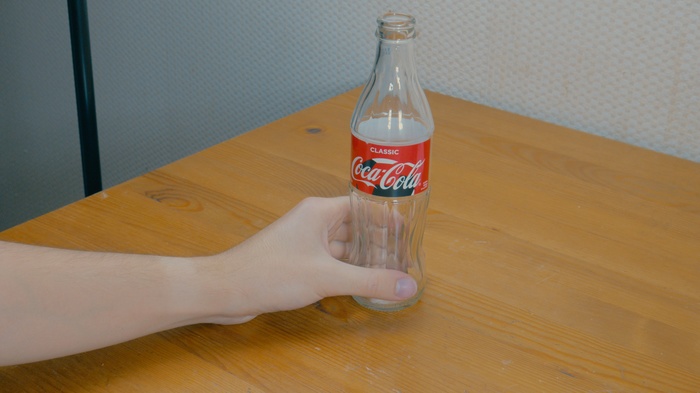
После истребления содержимого, бутылка была отложена в сторону, так как для нее необходимо было создать подставку. В качестве сырья для платформы было выбрано дерево, а конкретнее – сосновая дощечка 20*10*2 см. Из нее с помощью лобзика я выпили круг, причем умышленно он был создан неровным, так как мы создаем вещь из постапокалипсиса, какая симметрия, о чем вы!
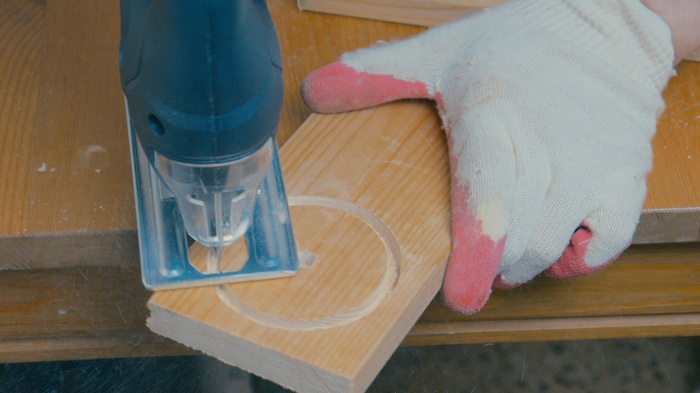
После этого начался этап обработки. Необходимо было закруглить края и все тщательно отшкурить, чтобы не осталось никаких заусенцев.
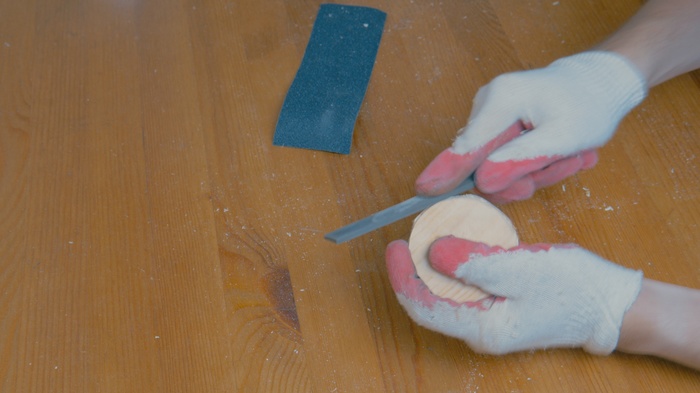
По задумке в подставку я решил встроить осветительный элемент, соответственно, для всей электроники необходимо было сделать техническое отверстие. Так как я не обладаю широким набором столярных инструментов в ход пошло все, что имею. Отметив нужную глубину на сверле, я принялся сверлить множество дырочек в области, которая отводилась под светодиод и батарейки.
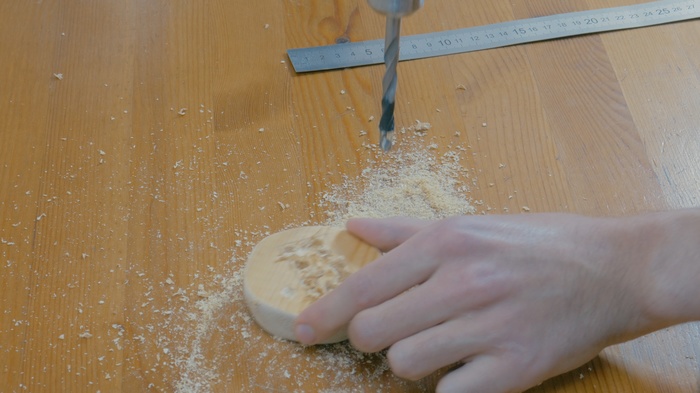
Ха-ха однако наделать дыр это еще полбеды! Теперь нужно было превратить этот ужас трипофоба в аккуратный прямоугольный карман. Для этого использовалась все – дрель, стамеска и насадка для гравера.
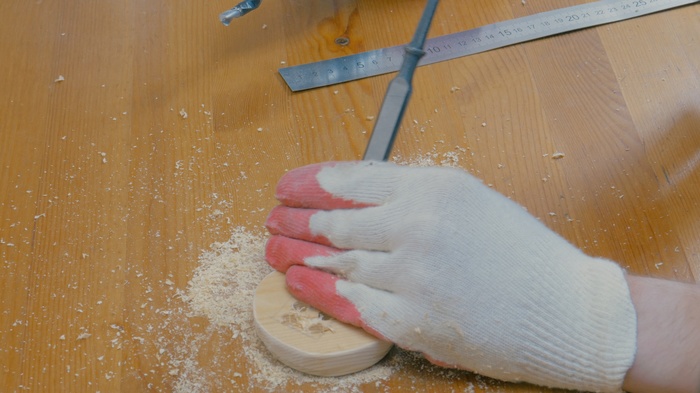
Теперь обрабатываем все шкуркой и получаем следующий результат
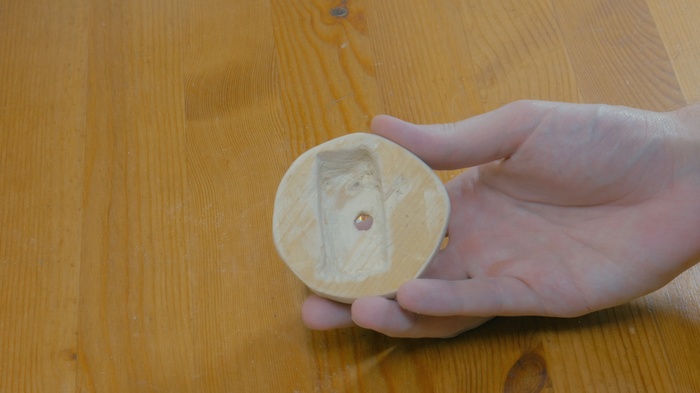
Получилось не столь аккуратно, но после того как мы встроим электронику, это дело можно будет закрыть картонной накладкой, которую мы посадим на двусторонний скотч. Ну а пока давайте украсим нашу подставочку!
И делать это мы будем с помощью трафарета и красок. Для столь маленького трафарета рекомендую использовать лезвие для бритья, канцелярский нож может оказаться слишком толстым.
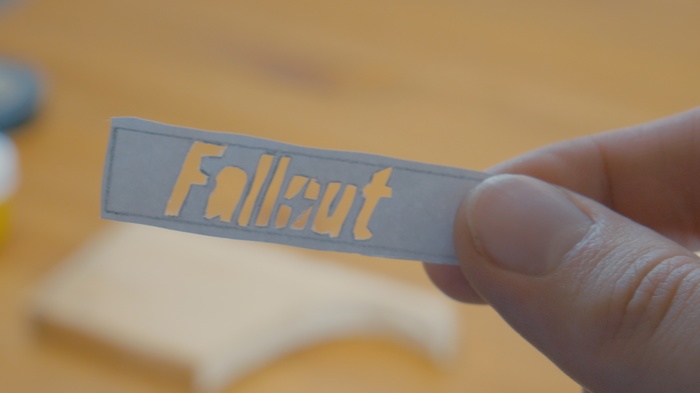
Приклеиваем трафарет на изоленту и закрашиваем обычной желтой гуашью. Гуашь дает приятную шероховатую поверхность, а для долговечности можно покрыть сверху лаком.
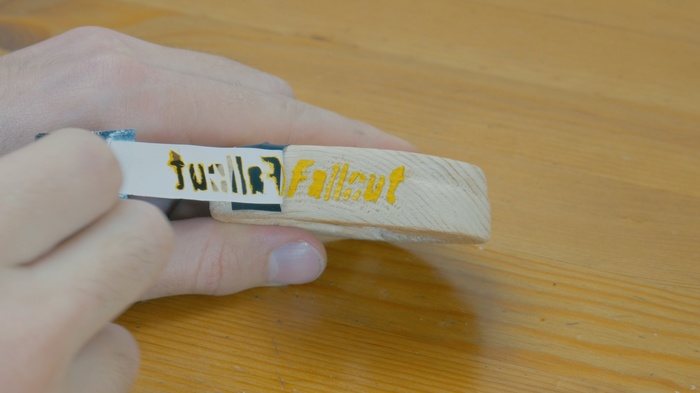
Теперь перейдем к начинке. В качестве донора я выбрал самый дешевый китайский фонарик. Чтобы его разобрать достаточно на него дунуть, так как при его сборке не использовали клея.
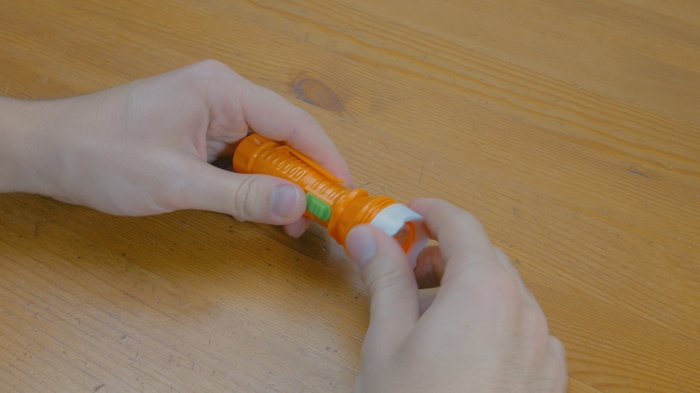
Также нам нужны два проводка и выключатель.
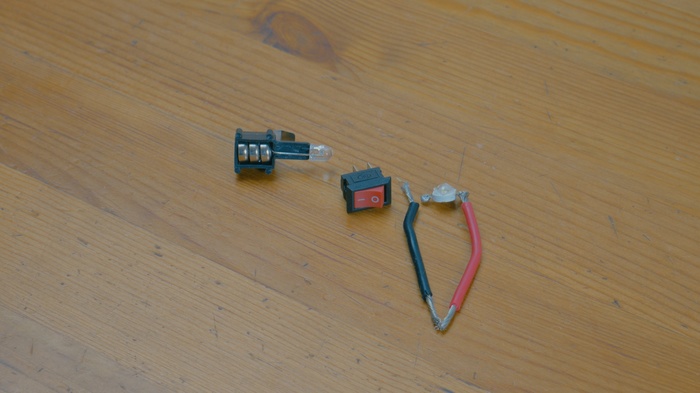
Теперь все это дело спаиваем и получаем следующего Франкенштейна.
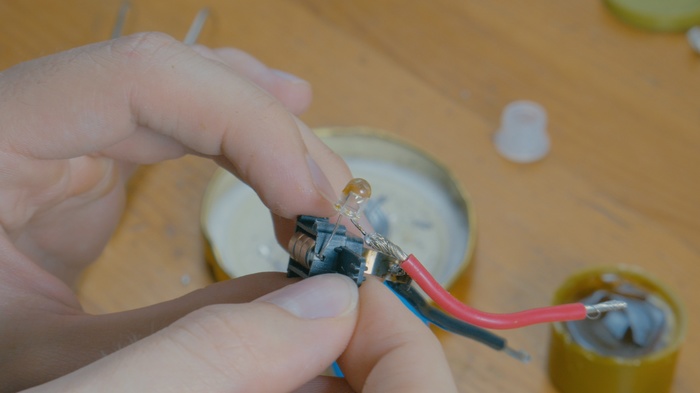
Качество работ оставляет желать лучшего. НО! Я обещаю, что буду совершенствоваться и вам не будет хотеться оторвать мне руки, при виде этого ужаса.
Осталось лишь примерить осветительный элемент и сделать еще одно отверстие для тумблера.
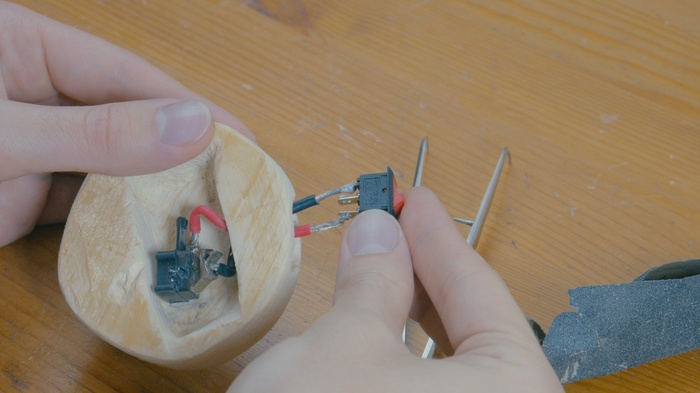
Наконец-то все запаиваем, заливаем из клеевого пистолета и прячем под картонку.
Настало время вернутся к заветной бутылочке, вы ведь не думали, что мы оставим ее без дела?
Удаляем этикетку и губкой оттираем остатки клея. По завершению этой операции сажаем бутылку на подставку с помощью все того же клеевого пистолета.
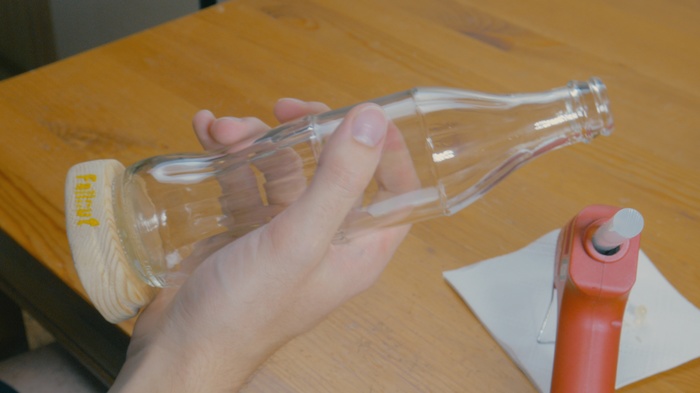
Теперь нам нужно наклеить этикетки, макет которых легко серфится в интернете (при необходимости скину в комментарии). Я решил распечатать их сразу на клеящейся глянцевой бумаге, чтобы не мучатся.
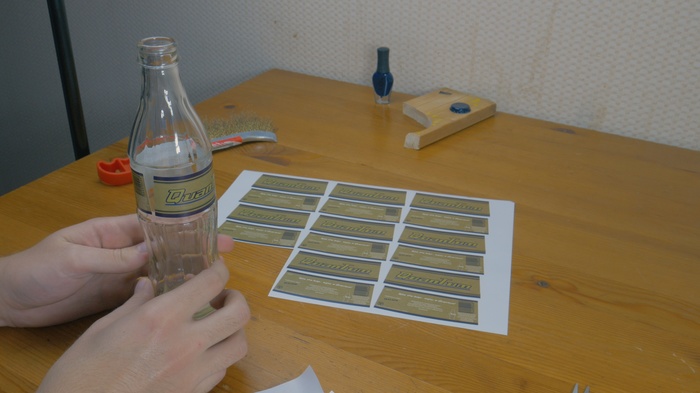
Не забываем покрасить крышечку в цвет верхней линии этикетки!
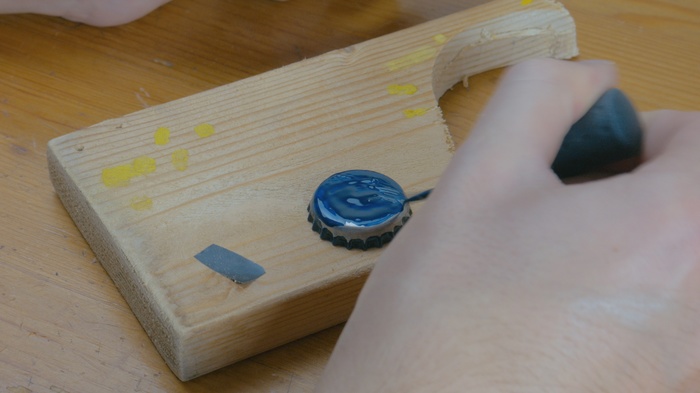
Переходим к самому интересному! Нам нужно придумать то, что будет наполнять нашу прекрасную Квантум Колу. Вариантов существует множество: вода+пищевые красители, омывайка для машины, powerade и т.д. Я решил отказаться от пищевых вариантов, чтобы исключить процессы разложения, ведь мы делаем вещь на века! Мой выбор пал на стеклоочиститель.
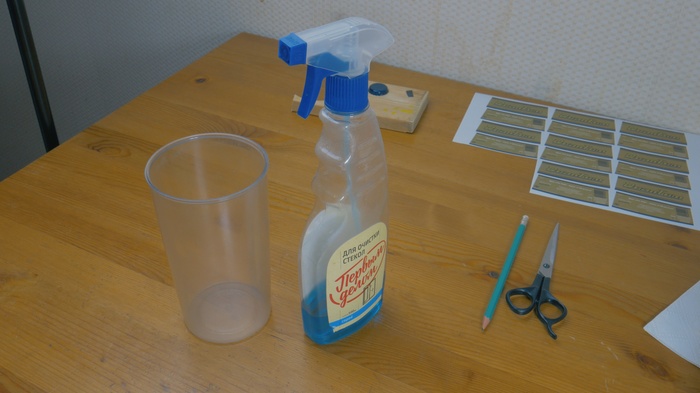
Я разбавил его водой и залил через воронку в бутылку. Теперь осталось лишь посадить крышку на свое законное место с помощью клея.
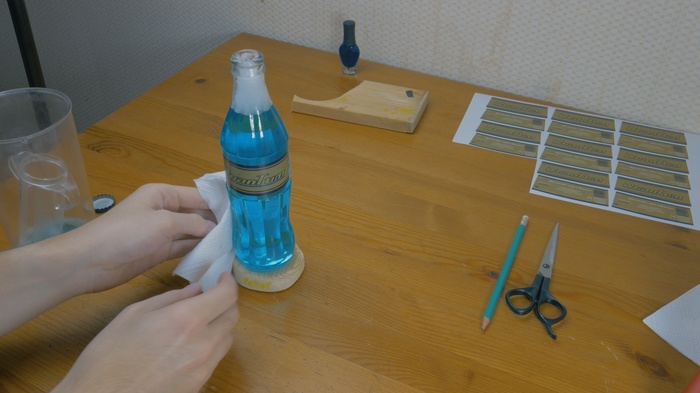
И. Ура! Мы можем насладиться финальным результатом!
*вспоминаем главную тему из меню Fallouta’a и переносим сознание в мир опасных пустошей*
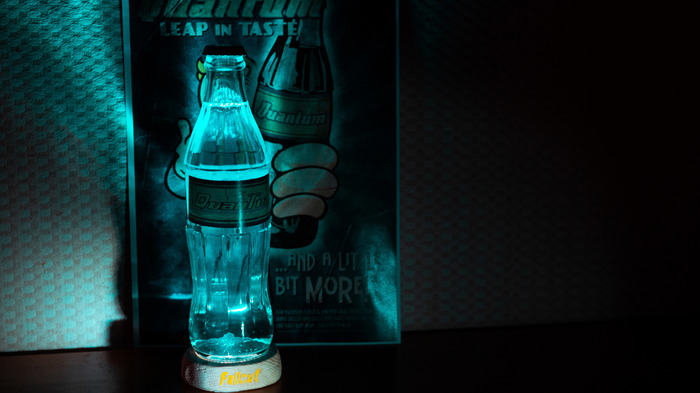
Друзья, я очень надеюсь, что этот пост вдохновит вас на свои прекрасные и замечательные самоделки.
Это мой первый пост и я с радостью хотел был услышать вашу критику в комментариях.
